Hamilton Watch Company, Lancaster, PA
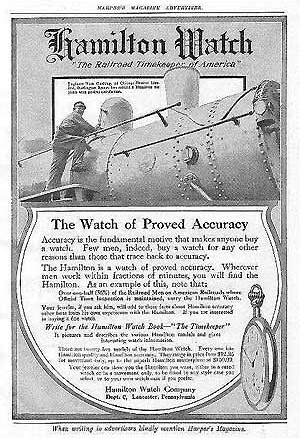
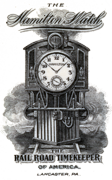 The Hamilton Watch Company traces its roots to the Adams & Perry Watch Company, founded by John C. Adams and E. H. Perry, in Lancaster, Pennsylvania in September 1874. Construction of a new brick factory building, designed by Chicago-architect Clarence Luther Stiles in the Second Empire style, located along the Columbia Turnpike, began in the Fall of 1874. Watch production began in 1875, the first movement was completed in April, 1876. In June 1876 Adams & Perry went into receivership.
The Hamilton Watch Company traces its roots to the Adams & Perry Watch Company, founded by John C. Adams and E. H. Perry, in Lancaster, Pennsylvania in September 1874. Construction of a new brick factory building, designed by Chicago-architect Clarence Luther Stiles in the Second Empire style, located along the Columbia Turnpike, began in the Fall of 1874. Watch production began in 1875, the first movement was completed in April, 1876. In June 1876 Adams & Perry went into receivership.
In need of additional capital to market their product, the company was reorganized, forming a new corporation, the Lancaster, Pa., Watch Company which restarted production in September 1877. Following more financial difficulties, the company reorganized again forming the Lancaster, Pa., Watch Co. Ltd. in 1878, and the Lancaster Watch Company in May 1879. Abraham Bitner gained control of the company in 1884, he was also the general manager / factory superintendant. The Lancaster Watch Company continued to suffer financial pains.
The company was reorganized again in 1886, this time as the Keystone Standard Watch Company, primarily selling lower quality watches. Henry J Cain replaced Bitner as superintendant in mid-1889 and began reorganizing the factory with the goal of introducing a new product line. Cain left by mid-1890, and the Keystone Standard Watch Company soon went into bankruptcy.
In August 1890 a group of Aurora investors including Henry Cain and Charles D. Rood purchased the the Aurora Watch Company in Aurora, Illinois at auction. The Aurora Watch Co. had been producing high-grade and mid-grade watches since 1884, however the company had gone into receivership in late 1889. Cain became superintendent of the Aurora Watch Co. reopening the Aurora factory in October 1890. By mid-1891 Henry Cain began designing a new line of railroad style movements.1
Hamilton Watch Company Established
In June 1892 a group composed of mostly Lancaster residents, including J.W.B. Bausman, John F. Brimmer, Henry. J. Cain, H. B. Cochran, F. P. Coho, C. A. Foundersmith, George H. Franklin, Charles D. Rood, W. Z. Sener, James Shand and H. S. Williamson, purchased the Keystone Standard Watch Company factory following a bankruptcy auction.2 In October Charles Rood and his Lancaster associates purchased the Aurora Watch Company of Aurora, Illinois.  The Keystone Standard Watch Company was merged with Aurora Watch Co. and the Hamilton Watch Company was established in October 1892. J.W.B. Bausman was elected President of the new company. The Hamilton name was selected to honor Andrew Hamilton and his son James, original owners of the site of Lancaster, credited with founding the city of Lancaster.
The Keystone Standard Watch Company was merged with Aurora Watch Co. and the Hamilton Watch Company was established in October 1892. J.W.B. Bausman was elected President of the new company. The Hamilton name was selected to honor Andrew Hamilton and his son James, original owners of the site of Lancaster, credited with founding the city of Lancaster.
Aurora machinery was loaded into in railroad cars and moved to Lancaster late in the Fall of 1892. The former Keystone Standard plant was enlarged by adding an east wing and the machinery from both companies was combined to manufacture the new Hamilton Watch. Production began on a new high quality 18-size, 17-jewel, open face, full-plate nickel movement, designed by Henry J. Cain, grade No. 936, which was intended for sale to the expanding railroad market. Charles Rood was elected President of the Hamilton Watch Co. in 1894.
From the start, the Hamilton Watch Co. positioned itself as a manufacturer of quality watches for the railroad market. The rugged, precision watch that Hamilton produced became a favorite among railroad watch inspectors and personnel. For about 50 years, over 50% of the pocket watches it produced were the high grade necessary for use in the railroad market. By the turn of the century Hamilton marketing adopted the slogan "Hamilton – The Railroad Timekeeper of America."
18 Size Movements Manufactured for Railroad Service
Grade No. 936, an open face, 17-jewel, adjusted to 5 positions, lever set movement, was the first watch made under the Hamilton name. It was manufactured to meet railroad standards, introduced in 1893, and continued to be manufactured until 1915. Originally designed with a single-roller escapement, it was upgraded to double-roller escapement around 1906. Grade No. 937, a hunting case, 17-jewel, adjusted to 5 positions, pocket watch movement was also released in 1893, manufactured until 1914, for those who preferred a hunting case watch.
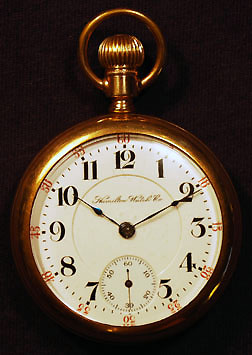 Grade No. 940, an open face, 21-jewel, adjusted to 5 positions, lever-set movement was Hamilton's most popular 18-size movement, produced from 1898 to 1928, over 209,000 of the movements were manufactured. During the 30 years of production the movements manufactured evolved, including an upgraded escapement from single-roller to double-roller around 1906, and an upgraded mainspring barrel from a going barrel to a motor barrel around 1908. Grade No. 941 was the corresponding 21-jewel, hunting case version, available from 1898 to 1920 was also popular with over 26,000 movements manufactured.
Grade No. 940, an open face, 21-jewel, adjusted to 5 positions, lever-set movement was Hamilton's most popular 18-size movement, produced from 1898 to 1928, over 209,000 of the movements were manufactured. During the 30 years of production the movements manufactured evolved, including an upgraded escapement from single-roller to double-roller around 1906, and an upgraded mainspring barrel from a going barrel to a motor barrel around 1908. Grade No. 941 was the corresponding 21-jewel, hunting case version, available from 1898 to 1920 was also popular with over 26,000 movements manufactured.
Other 18-size pocket watch movements manufactured to meet railroad time service requirements included:
- Grade No. 946, open face, 23-jewel, adjusted to 5 positions, D.R. mfg. 1904-1921,
- Grade No. 947, hunting case, 23-jewel, adjusted to 5 positions, D.R. mfg. 1910-1916,
- Grade No. 942, open face, 21-jewel, adjusted to 5 positions, mfg. D.R. 1898-1914,
- Grade No. 943, hunting case, 21-jewel, adjusted to 5 positions, mfg. D.R. 1898-1908,
- Grade No. 944, open face, 19-jewel, adjusted to 5 positions, D.R. mfg. 1905-1906,
- Grade No. 938, open face, 17-jewel, adjusted to 5 positions, D.R. mfg. 1894-1907,
- Grade No. 939, hunting case, 17-jewel, adjusted to 5 positions, D.R. mfg. 1894-1903,
- Grade No. 948, open face, 17-jewel, adjusted to 3 positions, mfg. D.R. 1912-1920
- Grade No. 934, open face, 17-jewel, adjusted, mfg. S.R. 1894-1909
- Grade No. 935, hunting case, 17-jewel, adjusted, mfg. S.R. 1894-19093, 4.
16-Size Movements Manufactured for Railroad Service
 Hamilton began producing 16-size watches for railroad service in 1896. Popularity of 16-size movements had increased after the establishment of railroad standards in 1892, reaching 15% of production by the turn of the century. Total 16-size watch movement production exceeded 18-size watches by 1915.
Hamilton began producing 16-size watches for railroad service in 1896. Popularity of 16-size movements had increased after the establishment of railroad standards in 1892, reaching 15% of production by the turn of the century. Total 16-size watch movement production exceeded 18-size watches by 1915.
Grade No. 960, open face, 21-jewel, was introduced in 1896 initially available only as pendant set, a lever set version was added in 1904, it was manufactured thorough 1915. Grade No. 962, open face, 17-jewel, pendant set only, was introduced in 1896 and discontinued in 1897. Hunting case grade No. 961, 21-jewel and grade No. 963, 17-jewel were also manufactured. All were adjusted to 5 positions and manufactured with a double roller escapement.
Grade No. 992, a 16-size, open face, 21-jewel, adjusted to 5 positions movement, produced from 1903 to 1940, was Hamilton's most popular. During the 28 years of production the grade No. 992 movements manufactured evolved, including an upgraded escapement from single-roller to double-roller around 1906, were re-introduced as optionally factory cased in 1924, and upgraded with an Elinvar hair spring and monometalic balance in 1931. By 1914 over 100,000 grade No. 992 had been made. By 1940 well over 610,000 grade No. 992 were made, making it is the most popular railroad watch ever built.
Grade No. 992B replaced the No. 992 in 1940. Produced through 1969, over 525,000 of the popular No. 992B watches were made.
Other 16-size pocket watch movements manufactured to meet railroad time service requirements included:
- Grade No. 950, open face, 23-jewel, adjusted 5 positions, D.R. mfg. 1909-1941,
- Grade No. 950B, open face, 23-jewel, adjusted 5 positions, D.R. mfg. 1941-1968,
- Grade No. 951, hunting case, 23-jewel, adjusted 5 positions, D.R. mfg. 1913-1918,
- Grade No. 990, open face, 21-jewel, adjusted 5 positions, D.R. mfg. 1903-1919,
- Grade No. 991, hunting case, 21-jewel, adjusted 5 positions, D.R. mfg. 1905-1908,
- Grade No. 993, hunting case, 21-jewel, adjusted 5 positions, D.R. mfg. 1905-1924,
- Grade No. 994, open face, 21-jewel, adjusted 5 positions, D.R. mfg. 1913-1920,
- Grade No. 970, open face, 21-jewel, adjusted 5 positions, D.R., P.S. mfg. 1901-1910,
- Grade No. 971, hunting case, 21-jewel, adjusted 5 positions, D.R., P.S. mfg. 1901-1907,
- Grade No. 952, open face, 19-jewel, adjusted 5 positions, D.R. mfg. 1909-1924,
- Grade No. 996, open face, 19-jewel, adjusted 5 positions, D.R. mfg. 1915-1928,
- Grade No. 954, open face, 17-jewel, adjusted 5 positions, D.R. mfg. 1910-1913,
- Grade No. 972, open face, 17-jewel, adjusted 5 positions, S.R. and D.R. mfg. 1904-1924,
- Grade No. 973, hunting case, 17-jewel, adjusted 5 positions, S.R. and D.R. mfg. 1905-1914,
- Grade No. 978, open face, 17-jewel, adjusted 3 positions, D.R. mfg. 1912-19243, 5
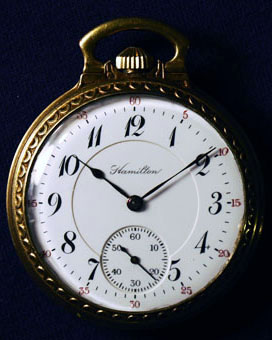
It should be noted that most major railroads only approved open face watch movements in open face cases after 1907-1908, although some railroads continued to accept hunting case movements in hunting cases until the early 1920's. Pendant-set watches were commonly accepted until 1906-1908.
Following a survey conducted in 1912 among official railroad watch inspectors, the company began advertising the fact that "Over one-half (almost 56%) of the Engineers, Conductors and Trainmen on the railroads of America where official time inspection is maintained carry the Hamilton Watch."
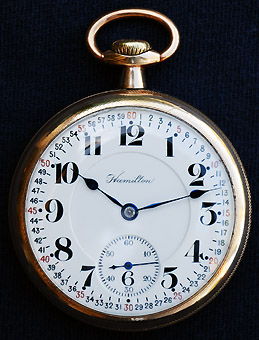 Hamilton also produced 18-size and 16-size pocket watch movements for the Ball Watch Company, an estimated 100,000 movements were manufactured for Ball from 1895 to 1954. Most of these were grade No. 999, inspired by New York Central and Hudson River Railroad locomotive 999, a 4-4-0 type that achieved a speed record of 112.5 miles per hour on May 10, 1893. "999" was trademarked by Ball in January 1896.
Hamilton also produced 18-size and 16-size pocket watch movements for the Ball Watch Company, an estimated 100,000 movements were manufactured for Ball from 1895 to 1954. Most of these were grade No. 999, inspired by New York Central and Hudson River Railroad locomotive 999, a 4-4-0 type that achieved a speed record of 112.5 miles per hour on May 10, 1893. "999" was trademarked by Ball in January 1896.
Hamilton expanded its product line by introducing 0-size movements for women in 1908, these were designed to be worn suspended from a breast pin. 12-size pocket watch movements for gentlemen were introduced in 1909. 6/0-size women's wristlet watches were introduced in 1912. Hamilton introduced its first wristwatch for men in 1917, designed to appeal to men entering World War I. The soldiers found the wrist watches, often referred to as trench watches, could be more easily read when the soldiers hands were full and were more convenient to use than pocket watches. After World War I consumer market demand switched from pocket watches to wrist watches, the company manufactured wrist watches for civilian use.
Hamilton was successful through the 1920s, buying the Illinois Watch Co. in 1928. Trademarks of the E. Howard Watch Company were acquired by Hamilton in 1931. Hamilton introduced the Elinvar hairspring, patented in 1931. The name Elinvar was derived from the term "Elasticity Invariable" and was the first alloy to resist the changes in elasticity that occur with changes in temperature helping ensure even more consistent accuracy.
During World War II, production of consumer watches was stopped, more than one million watches were shipped overseas to troops. Hamilton also produced several models of chronometers to meet the US Armed Forces need for an extremely accurate timepiece  which could be used for navigation at sea. The first Hamilton chronometers were delivered to the Navy in February 1942.
which could be used for navigation at sea. The first Hamilton chronometers were delivered to the Navy in February 1942.
In 1957, Hamilton introduced the world's first electric watch, the Hamilton Electric 500. In the early 1960's Hamilton produced a railroad electric wrist watch using a Hamilton 505 movement, which was briefly approved for use on some railroads, although it was later withdrawn due to issues with reliability.
In 1966, Hamilton acquired the Buren Watch Company in Switzerland, including all factories and technologies that had been developed by Buren up to that point. Hamilton and Buren were operated as a joint concern.
Last American Manufactured Railroad Pocket Watch
The last American manufactured railroad pocket watch was the grade No. 992B sold by the Hamilton Watch Co. in 1969. Watch production ceased in the U.S. in 1969, with the closure of its factory in Lancaster, although watches were still being assembled from parts and finished for several more years. Watch manufacturing operations were moved to the Buren factory in Switzerland.
The Hamilton Watch Company changed their name to HMW at the time they sold their Watch division to SSIH in 1971. Through the enforced merger of SSIH and ASUAG Groups in 1984, Hamilton has become a subsidiary of the The Swatch Group Ltd. The Hamilton Watch factory complex in Lancaster was added to the National Register of Historic Places in 1982, the main building has been converted into luxury apartments and condominiums.
Hamilton railroad grade watches (not all were railroad approved)
The following is from list of railroad grade watches which is generally attributed Webb C. Ball. List appears to be from around 1908-1909.  Not all of these were railroad approved even though all were listed as railroad grade.
Not all of these were railroad approved even though all were listed as railroad grade.
- 18-size: Grade 946, 23J
- Grades 940, 942, 21J
- Grade 944, 19J
- Grades 9262, 9342, 936, 938, 948, 17J
- 16-size: Grades 950, 950B, 950E, 23J
- Grades 992, 992B, 992E, 954, 960, 970, 994, 990, 21J
- Grade 996, 19J
- Grades 972, 968, 964, 17J
Hamilton Production Dates by Serial Number
Note: These are approximate dates, actual dates may vary by years. Hamilton's pocket watch serial numbers weren't assigned in strict chronological order, blocks were allocated by watch size, so there can be substantial variation. The serial number being referred to is the serial number on the movement of the watch, not the case.6
| 1893 - 1 - 2,000 | 1906 - 500,000 | 1919 - 1,600,000 | 1932 - 2,440,000 |
| 1894 - 5,000 | 1907 - 580,000 | 1920 - 1,700,000 | 1933 - 2,480,000 |
| 1895 - 11,500 | 1908 - 680,000 | 1921 - 1,800,000 | 1934 - 2,520,000 |
| 1896 - 16,000 | 1909 - 750,000 | 1922 - 1,900,000 | 1935 - 2,560,000 |
| 1897 - 27,000 | 1910 - 790,000 | 1923 - 2,000,000 | 1936 - 2,600,000 |
| 1898 - 50,000 | 1911 - 860,000 | 1924 - 2,050,000 | 1937 - 2,900,000 |
| 1899 - 74,000 | 1912 - 940,000 | 1925 - 2,100,000 | 1938 - 3,200,000 |
| 1900 - 104,000 | 1913 - 1,000,000 | 1926 - 2,150,000 | 1939 - 3,400,000 |
| 1901 - 143,000 | 1914 - 1,100,000 | 1927 - 2,200,000 | 1940 - 4,000,000 |
| 1902 - 196,000 | 1915 - 1,200,000 | 1928 - 2,250,000 | 1941 - 4,250,000 |
| 1903 - 260,000 | 1916 - 1,300,000 | 1929 - 2,300,000 | 1942 - 4,500,000 |
| 1904 - 340,000 | 1917 - 1,400,000 | 1930 - 2,350,000 | |
| 1905 - 435,000 | 1918 - 1,500,000 | 1931 - 2,400,000 |
| 992B w/ 1st letter C | 1956 - C455,000 | 950B w/ 1st letter S | 4992B w/ 1st letters 4C |
| 1940 - C001 | 1959 - C500,000 | 1941 - S001 | 1941 - 4CXXXX |
| 1941 - C40,000 | 1964 - C520,000 | 1944 - S1,500 | 1942 - 4C40,000 |
| 1942 - C60,000 | 1969 - C529,200 | 1945 - S2,800 | 1944 - 4C90,000 |
| 1943 - C90,000 | 1946 - S4,000 | 1950 - 4C120,000 | |
| 1944 - C120,000 | 950B w/ 1st letters 2B | 1947 - S4,500 | 1960 - 4C135,000 |
| 1946 - C170,000 | 1941 - 2B001 | 1948 - S6,500 | 1968 - 4C145,000 |
| 1947 - C215,000 | 1942 - 2B400 | 1949 - S7,500 | |
| 1948 - C255,000 | 1943 - 2B800 | 1951 - S10,000 | 3992B - 1943 to 1945 |
| 1950 - C350,000 | 1955 - S25,000 | ||
| 1951 - C390,000 | 1962 - S28,000 | ||
| 1954 - C420,000 | 1965 - S30,000 |
 |
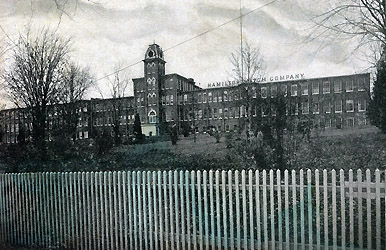 |
 |
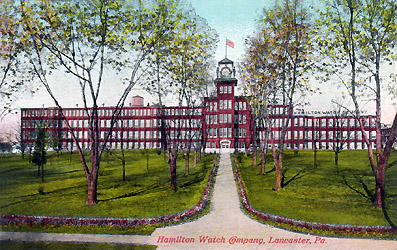 |
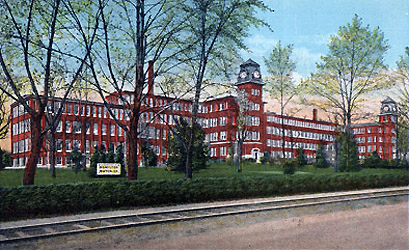 |
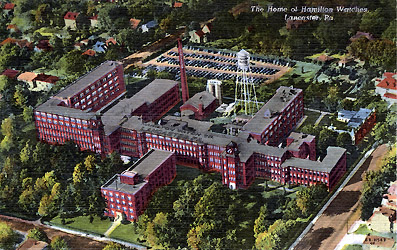 |
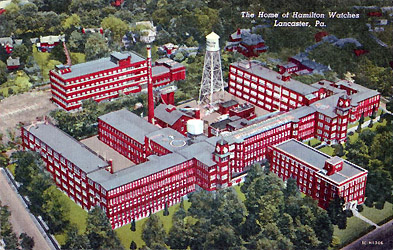 |
 |
Links to other sites for additional information:
Hamilton Museum - Historical information about the Hamilton Watch Co. provided by Hamilton International Ltd., A company of the Swatch Group.
Pocket Watch Database: - Serial number lookup and information for Hamilton, South Bend, Illinois, Rockford, Waltham & Elgin.
RRSTD's Hamilton Website - Documents the history, products and advertising of the Hamilton Watch Company.
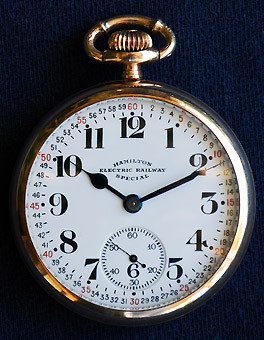 For additional reading:
For additional reading:
Erhardt, Roy, Hamilton Watch Co. Serial Numbers and Production Figures with Price Guide, Heart of America Press, Kansas City, MO, Revised Ed. 1981.
Erhardt, Roy and William "Bill" Meggers Jr., American Pocket Watches: Identification and Price Guide Beginning to End, Heart of America Press, Kansas City, MO, 1987.
The Hamilton Timekeeper, Every One a Masterpiece, Hamilton Watch Company, Lancaster, PA (circa 1913, no date).
McCollough, Robert Irving, Hamilton Watch Company Lancaster, Penna., U.S.A., Sone Notes on its founding and History, Part I - The "Ezra F Bowman Era", NAWCC Bulletin No. 115, April, 1965, pp. 731-739, Columbia, PA, 1965.
McCollough, Robert Irving, Hamilton Watch Company Lancaster, Penna., U.S.A., Sone Notes on its founding and History, Part II - "A Railroad Watch Is Born", NAWCC Bulletin No. 119, December, 1965, pp. 6-25, Columbia, PA, 1965.
McCollough, Robert Irving, Hamilton Watch Company Lancaster, Penna., U.S.A., Sone Notes on its founding and History, Part III, NAWCC Bulletin No. 124, October, 1966, pp. 484-518, Columbia, PA, 1966.
Sauers, Donald J. Time for America: Hamilton Watch, 1892-1992. Sutter House, Lititz, PA, 1992, ISBN 0-915010-36-4.
Ueberall, Ed and Kent Singer. Railroaders' Corner - Hamilton's Workhorse: The 940 (and its cousin, the 942), NAWCC Bulletin No. 322, October 1999, pp. 653-659.
Ueberall, Ed and Kent Singer. Railroaders' Corner - Hamilton's Ubiquitous 992 - Part 1, NAWCC Bulletin No. 332, June 2001, pp. 357-368.
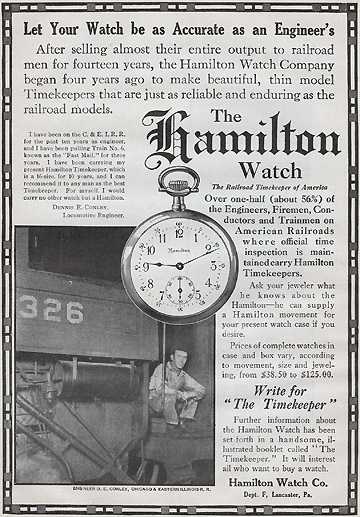
1 Harrold, Michael C. (MA) Charles Rood and Henry Cain; Origins of the Hamilton Watch Company, NAWCC Bulletin No. 340, Octobber, 2002, pp. 547-570, Columbia, PA, 2002.
2 McCollough, Robert Irving, Hamilton Watch Company Lancaster, Penna., U.S.A., Sone Notes on its founding and History, Part II - "A Railroad Watch Is Born", NAWCC Bulletin No. 119, December, 1965, pp. 6-25, Columbia, PA, 1965.
3 After 1906-1908 watches adjusted to 3 positions were only accepted for service on a limited number of railroads, most mainline railroads and a number of interurban railways had raised the minimum requirement to 5 positions. Watches adjusted to 3 positions remained popular on some interurban electric railways and street railways with less demanding requirements.
4 Hamilton 18-size Grades No. 926, open face, mfg. 1895 to 1923, and No. 927, hunting case, mfg. 1895 to 1912, both 17-jewel, lever set, adjusted to temperature (but not positions), single roller escapement, were likely accepted on some mainline railroads prior to the turn of the century, however other railroads, including those inspected by the Webb C. Ball organization required new watches entering railroad service to be adjusted to isochronism, temperature and position. The grade No. 926 continued to be popular on interurban electric railways with less demanding requirements, including the Pacific Electric Railway, after the turn of the century.
5 Hamilton Grade No. 974, a 16-size, open face, high grade 17-jewel, adjusted to temperature (but not positions), single roller escapement, pendant set mfg. 1897 to 1927, and lever set, mfg. 1905 to 1927, was advertised for and accepted by some electric railways and branches of railroad service with less demanding requirements. Some Grade No. 974 watches were sold with the signature "Hamilton Electric Railway Special" or later signature "Hamilton Electric - Interurban Special" on the dial as an option that could be selected. A estimated total of 311,500 Grade No. 974 watches were produced, making it one of Hamilton's most popular grades. In 1927 Grade No. 974 and Grade No. 978 were replaced by the upgraded Grade No. 974 Special, which was 16-size, open face, high grade 17-jewel, adjusted to temperature and 3 positions, with a double roller escapement. The Grade No. 974 Special was advertised as the Hamilton Traffic Special, part of the family of "Railroad Timekeepers... designed for the man whose need for an accurate and dependable watch makes him want the best." It continued to be manufactured through 1939.
6 More accurate Hamilton production date information for a specific movement can be found at the Pocket Watch Database website.
American Waltham Aurora Ball Columbus Elgin National Hamilton Hampden E.Howard Illinois Peoria Rockford South Bend Seth Thomas U.S.Marion U.S.Waltham
Sharing A Heritage Railroad History Train Technology Railroad Operation Railroad Time Museums & Heritage Railroads Railroads Today
